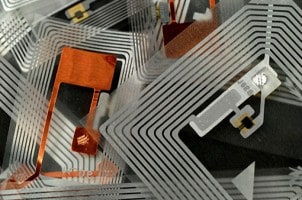RFID stands for Radio Frequency Identification and, this may surprise you, RFID is not new. In fact, it has been around since World War II and has been used in a wide variety of settings and applications. However, only recent developments have made RFID a practical means of changing the way retailers do business. But what is RFID, really?
Basically, RFID consists of a RF reader and a tag that contains a microchip and an antenna. The RF reader sends out an RF signal and listens for any tags within range to respond. One of RFID’s biggest advantages is that it is a non-line-of-sight solution. As a comparison, with bar codes, a scanner must actually be able to “see” the barcode on an item in order to read it. With RFID, this is not required. This means a tag can be read through product packaging, inside a shopping cart or shopping bag, or even through clothing.
However, the “read field” of the RF reader is not unlimited and is tied to the size of the tag and the amount of power available to it. One of the great advances in RFID technology was the development of “passive” tags. This means no battery or source of power is required on the tag itself. Instead, the tag uses power collected from the signal transmitted from the RF reader. However, because of the size of tags desirable in the retail setting and their lack of an independent power source, the read field is limited to a relatively small area.
In recent years, RFID has gained prominence and is being looked to for many different applications. There are five primary reasons for this new surge in interest.
1. The decreasing size of microchips and electronic components that allows a tag that is unobtrusive–as small as a grain of sand.
2. Development of global standards and protocols, such as EPC (electronic product code) and ISO.
3. The shrinking costs of both readers and tags, which makes use of the technology more likely to generate a convincing return on investment to the business community.
4. The implementation of IT infrastructures, equipment, and Internet capabilities that supports the adoption of RFID and allows for data generated to be stored, reported, and analyzed.
5. End-user demand and mandates from huge organizations that require suppliers to tag their products with RFID tags.
This article is excerpted from “Understanding the Impact of RFID on Retail.”


